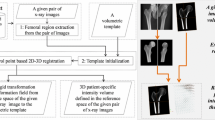Abstract
Although feasibility of accurate 3D reconstruction of the proximal epiphysis of the femur from biplanar X-rays (frontal and lateral) has been assessed, in vivo application is limited due to bone superposition. The aim of this study was to propose a specific algorithm to get accurate and reproducible, low dose in vivo 3D reconstruction. To achieve this goal, a parametric subject-specific model was introduced as a priori knowledge. This geometric model was based on a database based on proximal epiphysis of 60 femurs. The accuracy was estimated using comparisons to CT scans on 13 cadaveric femurs, then in vivo intra- and inter- observer reproducibility was assessed using a set of 23 femurs. The mean for the relative difference was 0.2 mm for the in vitro 3D accuracy. The mean error was 1.0 mm with maximum value of 5.1 mm in ideal conditions (in vitro). The confidence interval for the inter-observer reproducibility was within ±2.2 mm. This method gave us a reproducible tool in order to get in vivo 3D reconstructions of the femur proximal epiphysis from biplanar X-rays.






Similar content being viewed by others
References
Mahfouz MR et al (2003) A robust method for registration of three-dimensional knee implant models to two-dimensional fluoroscopy images. IEEE Trans Med Imaging 22(12):1561–1574
Sato T, Koga Y, Omori G. (2004) Three-dimensional lower extremity alignment assessment system: application to evaluation of component position after total knee arthroplasty. J Arthroplasty 19(5):620–628
Hagio K et al (2004) A novel system of four-dimensional motion analysis after total hip arthroplasty. J Orthop Res 22(3):665–670
Otake Y et al (2005) Four-dimensional model of the lower extremity after total hip arthroplasty. J Biomech 38(12):2397–2405
Bousson V et al (2006) Volumetric quantitative computed tomography of the proximal femur: relationships linking geometric and densitometric variables to bone strength. Role for compact bone. Osteoporos Int 17(6):855–864
Van Sint Jan S et al (2006) Low-dose computed tomography: a solution for in vivo medical imaging and accurate patient-specific 3D bone modeling? Clin Biomech (Bristol, Avon) 21(9):992–998
Gautsch TL, Johnson EE, Seeger LL (1994) True three dimensional stereographic display of 3D reconstructed CT scans of the pelvis and acetabulum. Clin Orthop Relat Res 305:138–151
Mortele KJ, McTavish J, Ros PR (2002) Current techniques of computed tomography. Helical CT, multidetector CT, and 3D reconstruction. Clin Liver Dis 6(1):29–52
Kalifa G et al (1998) Evaluation of a new low-dose digital x-ray device: first dosimetric and clinical results in children. Pediatr Radiol 28(7):557–561
Dubousset J et al (2005) A new 2D and 3D imaging approach to musculoskeletal physiology and pathology with low-dose radiation and the standing position: the EOS system. Bull Acad Natl Med 189(2):287–297 (discussion 297–300)
Fleute M, Lavallee S, Julliard R (1999) Incorporating a statistically based shape model into a system for computer-assisted anterior cruciate ligament surgery. Med Image Anal 3(3):209–222
Laporte S et al (2003) A biplanar reconstruction method based on 2D and 3D contours: application to the distal femur. Comput Methods Biomech Biomed Eng 6(1):1–6
Pomero V et al (2004) Fast accurate stereoradiographic 3D-reconstruction of the spine using a combined geometric and statistic model. Clin Biomech (Bristol, Avon) 19(3):240–247
Benameur S et al (2003) 3D/2D registration and segmentation of scoliotic vertebrae using statistical models. Comput Med Imaging Graph 27(5):321–337
Benameur S et al (2002) 3D biplanar statistical reconstruction of scoliotic vertebrae. Stud Health Technol Inform 91:281–285
Mitton D et al (2006) 3D reconstruction of the pelvis from bi-planar radiography. Comput Methods Biomech Biomed Eng 9(1):1–5
Le Bras A et al (2004) 3D reconstruction of the proximal femur with low-dose digital stereoradiography. Comput Aided Surg 9(3):51–57
Pomero V et al. (2003) Procede d’imagerie radiographique pour la reconstruction tridimensionnelle, dispositif et programme d’ordinateur pour mettre en œuvre ce procede Radiographic imaging method for three-dimensional reconstruction, device and computer software for carrying out said method
Mitton D et al (2000) 3D reconstruction method from biplanar radiography using non-stereocorresponding points and elastic deformable meshes. Med Biol Eng Comput 38(2):133–139
Mitulescu A et al (2001) Validation of the non-stereo corresponding points stereoradiographic 3D reconstruction technique. Med Biol Eng Comput 39(2):152–158
Author information
Authors and Affiliations
Corresponding authors
Rights and permissions
About this article
Cite this article
Baudoin, A., Skalli, W., de Guise, J.A. et al. Parametric subject-specific model for in vivo 3D reconstruction using bi-planar X-rays: application to the upper femoral extremity. Med Biol Eng Comput 46, 799–805 (2008). https://doi.org/10.1007/s11517-008-0353-8
Received:
Accepted:
Published:
Issue Date:
DOI: https://doi.org/10.1007/s11517-008-0353-8




